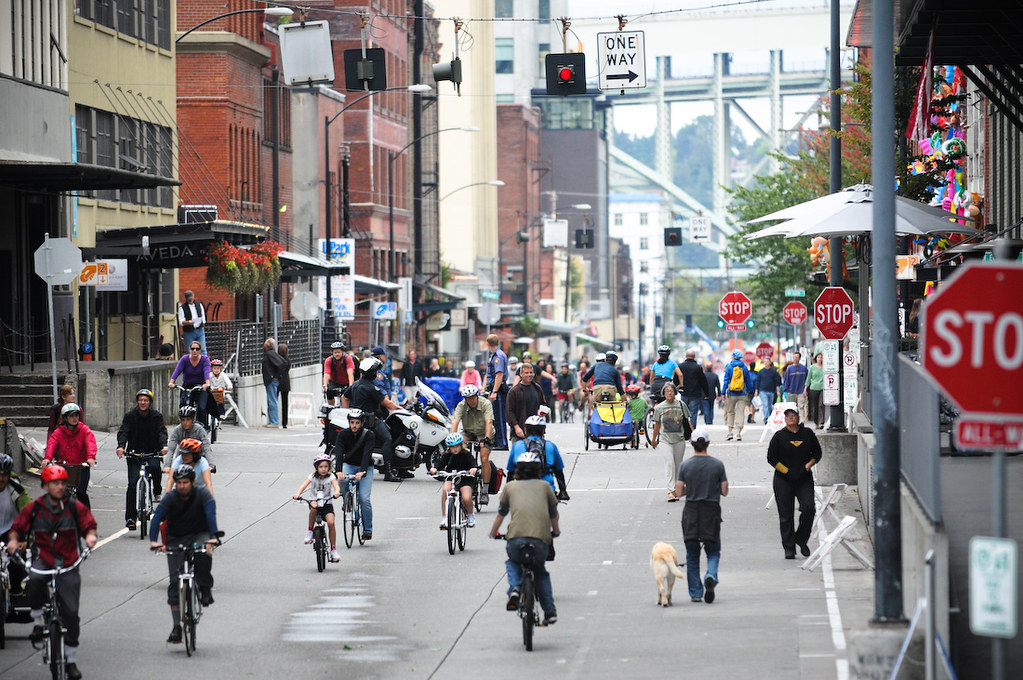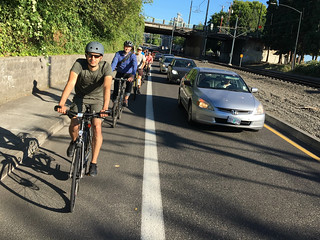What happened in lower Manhattan is a nightmare.
Unfortunately it’s a recurring one for many of us who ride bicycles in cities.
The idea that cars are weapons is not new to us. What’s new — now that even more innocent lives have been lost — is that thinking of cars as weapons isn’t as radical of an idea as it was 24 hours ago.
Cars are weapons. When someone drives one it becomes a loaded weapon. But unlike guns, cars are used by nearly everyone, everywhere, everyday. And unlike guns, cars don’t attract attention from authorities and they carry none of the constroversial stigma that guns do. On the contrary, cars and trucks are incessantly glorified in ways that normalize reckless disregard for everyone on the road except the all-important, all-powerful person behind the wheel. “Keep streets mean,” is Dodge’s irresponsible tagline.
Yesterday everyone saw just how “mean” streets can get when a man opened fire with a rental truck on that bike path. It has been officially tagged terrorism by authorities, making it just the latest in a disturbing global trend. Terrorist groups like ISIS encourage followers to use cars to inflict mass murder. These extremists have found our gaping weak spot. Like a Trojan Horse, weaponized automobiles are an easy way to breach America’s trillion dollar homeland security complex.
The disturbing thing is we didn’t need extremist propaganda to point out this vulnerability.
Just like America’s absurd inability to reign in gun violence has made us a laughingstock abroad, so too has our inability to reign in car abuse. Now we must add tool-for-mass-murder to the mile-long list of negative impacts we are all forced to live with due to the relatively unregulated use of motorized vehicles in this country.
What happened in Manhattan can happen in Portland.
On April 3rd of this year, Henry Nikila intentionally drove his car into a crowd of people in southeast Portland, injuring three of them. Why? They yelled at him to slow down.
Advertisement

On August 10th 2016, Russell Courtier used his Jeep to intentionally run over and kill Larnell Bruce. Bruce was black and Courtier had ties to white supremacy groups. The murder was ruled a hate crime.
And we’ve reported on numerous cases of intentional vehicular assault and of people who — for whatever reason — drove their cars onto bike-only paths.
To those of us who use bicycles as our daily vehicles, it doesn’t matter why people do these things. It’s the result of their actions we can’t stop thinking about.
Whether fueled by an ideological mission, malice, distraction, racial hatred, or road rage. Whether drunk with anger, alcohol, or religious fervor — there’s always one constant: the immense destructive potential of the automobile.
With anger in America — and anger towards America — at a breaking point, our transportation bureaus must act more like our police bureaus. Their job is no longer to just build roads, but to do whatever it takes to protect all the people who use them. There’s no homeland security until our bikeways and walkways are protected.
We don’t lack solutions, we lack the will to implement them. One solution stands out as both obvious and reasonable: More use of concrete barriers and steel bollards to keep drivers of cars and trucks away from vulnerable road users.
We use metal detectors to keep guns and knives out of buildings, we need bollards and barriers to keep cars out of bikeways.
An article in New York Magazine this morning makes the case:
The horror on the Hudson River Greeenway was an attack on pedestrians and cyclists. It was also eminently preventable. Sayfullo Saipov’s guns were fake, but his truck was real, and he used it to drive block after block after block, unimpeded by car traffic, free to crush Citi Bikes and their riders. He could do so because this ostensibly “protected” bike lane … isn’t…
In recent years, guided by Mayor Bill de Blasio’s allegiance to Vision Zero, the city keeps doling out new bike paths that are separated from ordinary traffic by raised curbs or parking spaces, or else just indicated by stripes of paint. That’s not enough…
We can’t crazy-proof all of New York, but the city could do a far more thorough job of safeguarding places where cyclists and pedestrians cluster.
We can choose to ignore the imminent threats Portlanders face on our streets everyday. We can keep planning and processing and promising forever. Or we can do something real and tangible about it. If our lofty “Vision Zero” proclamation is to have any shred of credibility, we’ll choose the latter.
For insights and updates from activists in Manhattan, follow @brooklynspoke, @transalt, @carolinesampo, @naparstek, @psteely, and @NYC_safestreets on Twitter.
— Jonathan Maus: (503) 706-8804, @jonathan_maus on Twitter and jonathan@bikeportland.org
Never miss a story. Sign-up for the daily BP Headlines email.
BikePortland needs your support.



